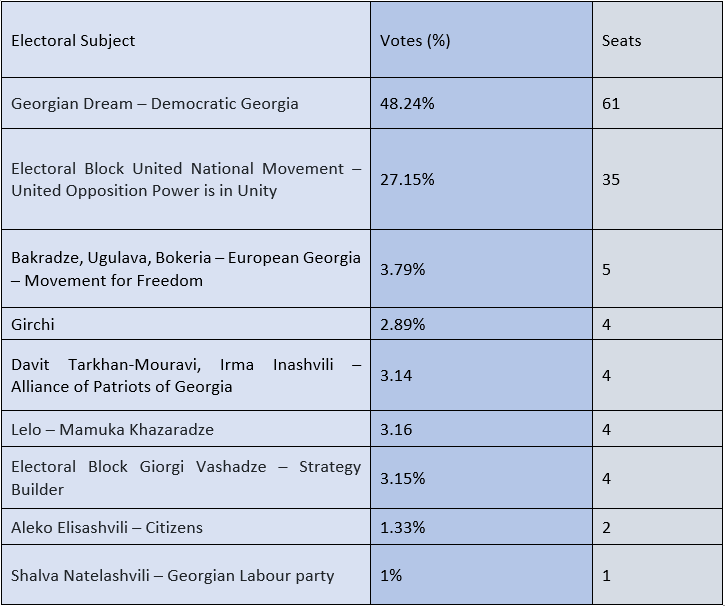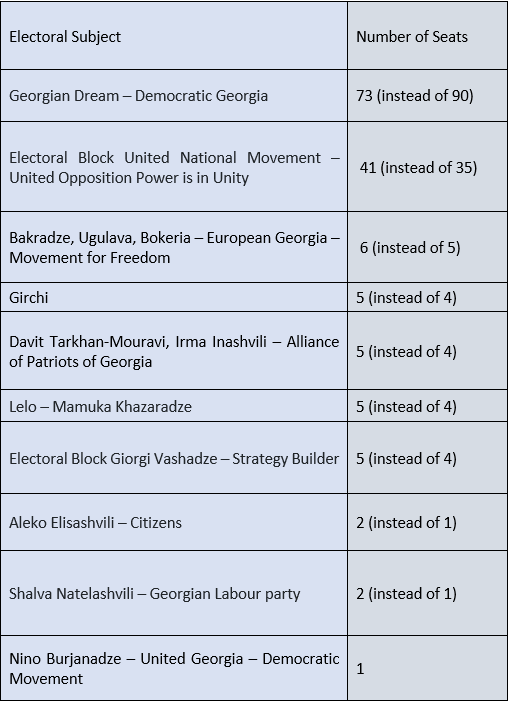Resume: If the parliamentary elections on 31 October 2020 had been held under the fully proportional system and with a natural threshold, ten electoral subjects would have gained seats in the parliament.
Analysis:
On 3 November 2020, Nino Tsilosani, MP, made the following statement on her Facebook page: “If fully proportional elections were held today, only the Georgian Dream and the United National Movement would have gained seats in the parliament based on these elections results. The Georgian Dream would have claimed nearly 100 seats and the United National Movement would have taken the rest of the mandates (because the mandate allocation rule is different in this case). Therefore, using the ‘time will tell’ principle, you perhaps understand how statesman-like was the decision of me and my friends to not support the transition to a fully proportional system from 2020. The fact that we have a multi-party parliament today is the result of that decision of ours.”
FactCheck would like to remind our readers that in response to the 20-21 June 2019 events, , the chairman of the ruling party, Bidzina Ivanishvili, openly announced on 24 June 2019 that the 2020 elections were going to be held with a natural threshold and in a fully proportional system. In spite of his public promise, on 14 November 2019, some members of the Parliamentary Majority voted down the constititional amendments initiated by 93 Georgian Dream MPs envisioning the transition to proportional elections. On 8 March 2020 and after months-long negotiations on the 2020 elections, the ruling party and the opposition reached an agreement to hold the elections under the 120/30 model with a 1% threshold.
According to the Central Election Commission (CEC), nine electoral subjects passed the 1% threshold in the parliamentary elections on 31 October 2020 (see Table 1). Although the final results have not yet been officially published, we can compare the available results based on the CEC’s current figures to potential results which could have occurred if the elections been held under a fully proportional system.
Table 1: 31 October 2020 Parliamentary Election Results

Source: Central Election Commission
The Georgian Dream garnered 48.24% of the proportionally cast votes (61 seats from proportional lists and 14 from single-mandate constituencies) and won in the first round. In total, the Georgian Dream took 75 seats. In addition, given the boycott from the opposition parties, we can say that the Georgian Dream will win the run-offs in the 16 remaining single-mandate constitutencies and have 90 seats in total.
If the elections were held under a fully proportional system with a natural threshold, the parties would have needed 0.67% of the total votes to get one mandate. Therefore, based on the aforementioned results, Nino Burjanadze’s party would have been added to the list of the foregoing parties and a total of ten electoral subjects would have won seats in the parliament. In this case, the allocation of seats would have been as follows had the election been held under a fully proportional system:
Table 2: Mandates Allocated Under a Fully Proportional System [1]

Source: CEC Results, author’s calculations
The table clearly shows that if the 31 October elections had been held under a fully proportional system, ten electoral subjects would have won seats in the parliament. Of additional note is that only the Georgian Dream would have its number of seats shrink (from 90 to 73) in this case whilst all other subjects would gained additional seats. Most importantly, a political party garnering the support of less than half of the people would not have been able to single-handedly form a government in the parliament of the 10th convocation. Therefore, Nino Tsilosani’s statement that if the elections were held under a fully proportional system, only the Georgian Dream and the United National Movement would have won seats in the parliament is a LIE.
[1] Results of only those electoral subjects which would have won seats in the parliament with a natural threshold are used for comparison here. Non-allocated mandates are not taken into account in this table. Therefore, the total number of mandates in the table is 145.








